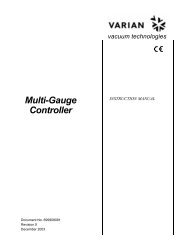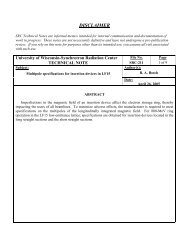SRC Users' Meeting - Synchrotron Radiation Center - University of ...
SRC Users' Meeting - Synchrotron Radiation Center - University of ...
SRC Users' Meeting - Synchrotron Radiation Center - University of ...
You also want an ePaper? Increase the reach of your titles
YUMPU automatically turns print PDFs into web optimized ePapers that Google loves.
MANY-ELECTRON EFFECTS ON THE XE 5S NONDIPOLE<br />
PHOTOELECTRON ASYMMETRY<br />
S. H. Southworth 1 , E. P. Kanter 1 , B. Krässig 1 , R. Guillemin 2 , O. Hemmers 2 ,<br />
D. W. Lindle 2 , and R. Wehlitz 3<br />
1 Argonne National Laboratory, Argonne, IL 60439*<br />
2 <strong>University</strong> <strong>of</strong> Nevada, Las Vegas, NV 89154<br />
3 <strong>SRC</strong>, <strong>University</strong> <strong>of</strong> Wisconsin, Stoughton, WI 53589<br />
Photoionization <strong>of</strong> the Xe 5s subshell has been extensively studied because <strong>of</strong> its<br />
sensitivity to relativistic and many-electron interactions. Previous studies <strong>of</strong> the partial cross<br />
section and the photoelectron anisotropy parameter are sensitive to the electric-dipole<br />
photoionization amplitudes. Recently, the nondipole asymmetry parameter has been calculated<br />
and is sensitive to both electric-dipole and electric-quadrupole photoexcitation channels [1,2].<br />
We measured over the 26–140 eV photon energy range at the <strong>SRC</strong> and combined our results<br />
with measurements made over 80–197.5 eV at the ALS. Measurements over the 90–225 eV<br />
region were also reported in Ref [3]. In<br />
Asymmetry parameter γ<br />
1<br />
0.5<br />
0<br />
-0.5<br />
HF<br />
Xe 5s<br />
RRPA<br />
RPAE<br />
-1<br />
50 100 150 200<br />
Photon energy (eV)<br />
Fig. 1. Xe 5s nondipole asymmetry parameters measured at<br />
the <strong>SRC</strong> (open circles) and ALS (closed circles) compared<br />
with HF (dotted curve), RPAE (dashed curve), and RRPA<br />
(solid curve) calculations.<br />
Fig. 1, the <strong>SRC</strong> and ALS results are<br />
compared with Hartree-Fock (HF) [1],<br />
random-phase approximation with<br />
exchange (RPAE) [1], and relativistic<br />
random-phase approximation (RRPA)<br />
[2] calculations. (The curves plotted in<br />
Fig. 1 are based on more accurate<br />
calculations than were originally<br />
reported in Refs. [1,2]; see Ref. [4].)<br />
The parameter varies rapidly near<br />
threshold and passes through a<br />
minimum near 35 eV. This is due to<br />
the 5s p (dipole) amplitude passing<br />
through a "Cooper minimum," and is<br />
essentially a one-electron effect but is<br />
modified by interchannel coupling with<br />
the 5p and 4d subshells and by ionic-state satellite channels. The broad maximum near 150 eV<br />
results mainly from interchannel coupling with the 4d subshell, which is included in the RPAE<br />
and RRPA calculations but not HF. The small feature measured near 160 eV and predicted by<br />
the RRPA calculation results from coupling <strong>of</strong> the 5s d (quadrupole) channels with the 4p <br />
f quadrupole shape resonances. A full report on this study is in Ref. [4].<br />
[1] M. Ya. Amusia et al., Phys. Rev. A 63, 052506 (2001).<br />
[2] W. R. Johnson and K. T. Cheng, Phys. Rev. A 63, 022504 (2001).<br />
[3] S. Ricz et al., Phys. Rev. A 67, 012712 (2003).<br />
[4] O. Hemmers et al., Phys. Rev. Lett. 91, 053002 (2003).<br />
*The ANL group is supported by the Chemical Sciences, Geosciences, and Biosciences Division, Office <strong>of</strong> Basic<br />
Energy Sciences, Office <strong>of</strong> Science, U.S. Dept. <strong>of</strong> Energy, under Contract No. W-31-109-Eng-38.
















